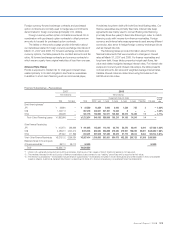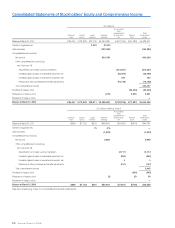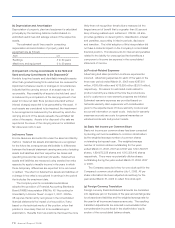Honda 2008 Annual Report Download - page 71
Download and view the complete annual report
Please find page 71 of the 2008 Honda annual report below. You can navigate through the pages in the report by either clicking on the pages listed below, or by using the keyword search tool below to find specific information within the annual report.
A n n u a l R e p o r t 2 0 0 8 6 9
Honda believes is commensurate with the risk free rate
plus a risk premium. Finance subsidiaries of the Company
have historically amortized servicing assets or servicing
liabilities in proportion to and over the period of estimated
net servicing income. Effective April 1, 2007, the finance
subsidiaries of the Company adopted Statement of Financial
Accounting Standards (SFAS) No. 156, “Accounting for
Servicing of Financial Assets” which requires the finance
subsidiaries of the Company to measure servicing assets
or servicing liabilities at fair value at each reporting date
and report changes in fair value in earnings in the period in
which the changes occur. The adoption of SFAS No. 156 did
not have a material impact on the Company’s consolidated
financial position as of April 1, 2007. Servicing assets and
servicing liabilities at March 31, 2007 and 2008 were not
significant.
Taxes collected from customers and remitted to
governmental authorities on revenue-producing transactions
are accounted for on a net basis and therefore are excluded
from revenues in consolidated statements of income.
(f) Cash Equivalents
Honda considers all highly liquid debt instruments with
an original maturity of three months or less to be cash
equivalents. Cash equivalents consist of money market
funds and commercial paper, and amount to ¥117,182 million
and ¥110,336 million ($1,101 million) as of March 31, 2007
and 2008, respectively.
(g) Inventories
Inventories are stated at the lower of cost, determined
principally by the first-in, first-out method, or market.
(h) Investments in Securities
Investments in securities consist of investment to affiliates
and debt and equity securities. Investments in affiliates in
which Honda has the ability to exercise significant influence
over their operating and financial policies, but where Honda
does not have a controlling financial interest are accounted
for using the equity method. Differences between the cost
of investments in affiliates and the amount of underlying
equity in net assets of the affiliates principally represent
investor level goodwill.
Honda considers whether the fair value of any of its
equity method investments have declined below their
carrying value whenever adverse events or changes in
circumstances indicate that recorded values may not be
recoverable. If Honda considers any such decline to be
other-than-temporary based on various factors, then a
write-down will be recorded to estimated fair value.
Honda classifies its debt and equity securities into the
following categories: available-for-sale, trading, or held-to-
maturity. Debt securities classified as “held-to-maturity”
securities are reported at amortized cost. Debt and equity
securities classified as “trading” securities are reported
at fair value, with unrealized gains and losses included in
earnings. Other marketable debt and equity securities are
classified as “available-for-sale” securities and are reported
at fair value, with unrealized gains or losses, net of deferred
taxes included in accumulated other comprehensive income
(loss) in the stockholders’ equity section of the consolidated
balance sheets. The costs of available-for-sale securities
sold are accounted for using the moving-average method.
Honda did not hold any “trading” securities at March 31,
2007 and 2008, except for retained interests in the sold
pools of finance receivables, which are accounted for as
“trading” securities and included in finance subsidiaries—
receivables.
Honda periodically compares the fair value of investment
securities with their cost basis. If the fair value of investment
securities has declined below our cost basis and such
decline is judged to be other-than-temporary, Honda
recognizes the impairment of the investment securities
and the carrying value is reduced to its fair value through
a charge to income. The determination of other-than-
temporary impairment is based upon an assessment of the
facts and circumstances related to each investment security.
In determining the nature and extent of impairment, Honda
considers such factors as financial and operating conditions
of the issuer, the industry in which the issuer operates,
degree and period of the decline in fair value and other
relevant factors.
Non-marketable equity securities are carried at cost, and
are examined the possibility of impairment periodically.
(i) Goodwill
Goodwill, all of which is allocated to Honda’s reporting
units, is not amortized but is tested for impairment at least
annually. Honda completed its annual tests for March 31,
2006, 2007, and 2008 and concluded no impairment needed
to be recognized. The carrying amount of goodwill at March
31, 2007 and 2008 was ¥20,791 million and ¥20,498 million
($205 million), respectively (see note 3).
(j) Property on Operating Leases
Property on operating leases is reported at cost, less
accumulated depreciation. Depreciation of the vehicles is
generally provided on a straight-line basis to an estimated
residual value over the lease term. The residual values of
the vehicles related to the operating leases are estimated by
using our estimate of future used vehicle values, taking into
consideration data obtained from third parties.
























